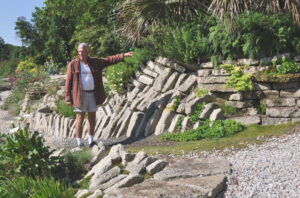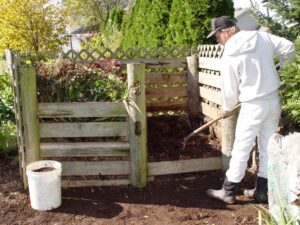Black Thumb? I Don’t Think So
August 15th, 2023
Two reasons explain why non-gardeners are non-gardeners (or ex-gardeners).
One is lack of time, the reason behind most every non-something.

Do some gardeners have naturally green thumbs (or brown gloves, as the case may be)?
The other is lack of confidence. Soil rookies either tried and failed, or they didn’t bother in the first place because they were pretty sure they’d fail if they did try. (Homer Simpson: “Trying is the first step toward failure.”)
Their conclusion: “I have a black thumb.”
Take heart, black-thumbers. This is one “malady” that’s curable.
In fact, I don’t even buy the notion that people either have a black thumb, or the sunnier reverse, a green thumb.
We’re not born with some innate talent to sidestep downy mildew on impatiens or grow two-pound tomatoes. We learn gardening by reading, by watching, and especially by doing.
A case in point is my own family.
My sister claims to have the world’s worst black thumb – someone who can kill a houseplant just by looking at it.
My brother barely knows the difference between a coneflower and a conehead.
Me? I’ve been fascinated by anything with chlorophyll ever since discovering the miracle of how a lifeless little seed can turn into a six-foot tomato plant that delivers delicious two-pound fruits.
I can spend hours comparing the foliage of different cultivars at Longwood Gardens and am as thrilled by new perennials at the garden center as kids getting Christmas gifts.
No wonder then that I have a bit more going on in the garden than my sister or brother. It’s not a case where two of us got short-changed on the gardening gene.
Experienced gardeners will tell you that most of their growing know-how can be found in their compost pile – specifically, what went wrong to earn those dead $15 perennials a home there.

This man (Tony Avent) has killed 60,000 plants.
Tony Avent nailed that point on a tour of his North Carolina Plant Delights nursery earlier this summer.
Avent is one of the world’s top plantsmen, but he also might hold the record for most plants killed.
In his mission to find more and better new plants for home gardeners, Avent says he’s grown some 85,000 different kinds of plants in his 36 years in business. He’s also killed a whopping 70 percent of them.
“We’ve killed 60,000 plants, but we’ve learned something from them all,” Avent says. “It’s more important for us to learn something than to be successful.”
If you can learn something from each of your struggles and failures, little by little you learn not only the general mysteries of plant-growing but the vagaries of your particular yard. Ultimately, you become a good gardener.
Look at your dead aster not as a reason to give up but as important progress in growing the next one superbly (or the one after that if you lean toward remedial learning).
Read more in my post on “What a Dead Plant Can Teach Us”
I’ve found that some of the best gardeners are ones who had a mom or dad or grandmother or grandfather who got them interested in gardening when young.
These people didn’t just inherit the right genetics. They were blessed with an early interest that gave them a big head start over those just getting started in their 30s or 40s or 60s.
So if you’re in the latter group, it’s not hopeless. You just have something catching up to do.
Here are six tips to help you fast-forward your way out of black-thumbness:

Compost bins are a sign of a gardener who’s making progress.
1.) Good soil. A common thread of successful gardeners is that almost all of them have compost piles. They know the value of organically rich, well drained, loose soil, and they recycle “fuel” from around the kitchen and yard to make that happen.
If you don’t have a compost pile or two, fall is a good time to start one. Otherwise, improve your lousy clay with purchased compost or falling leaves or mushroom soil or whatever organic gold you can get your paws on.
2.) Observe your site. You might not care where the sun hits at 2 p.m., but your plants do. Plants survive and thrive best when they’re in a site that suits their needs.
Most yards have a variety of conditions that create “microclimates” – pockets of varying temperature, light, wind, and moisture conditions that can make a life-or-death difference to plants.
Get to know these before you buy and plant. Pay attention to factors such as where it stays wet for days after a rain, where the snow melts first in winter, where the sun hits at 10 a.m. vs. 2 p.m., and where the wind blows piles of leaves in fall.
3.) Match plants to the site. Once you know what hand you’ve been dealt, match plants to your particulate microclimates. This is a lot easier than trying to change your conditions to match the plants you want.
Take time to do the homework. It’s cheaper in the long run than killing off 50 percent of what you plant in order to learn by trial and error.
I’ve been writing a “George’s Plant Pick of the Week” series for years for The Patriot-News and PennLive to help gardeners zero in on the best local plant choices. You can read each of the profiles (including details on exactly where best to plant each plant) on the Plant Profiles section of this site.
Also helpful is my 19-page “George’s Survivor Plants for Pennsylvania” booklet that’s available as a $4.95 download on the Buy Helpful Info section of this site.
Master Gardeners, garden-center staffers, and even your “green-thumb” neighbors are other viable plant-homework resources.

Start small with one or a few of a particular plant to be sure it’ll work before you invest too much.
4.) Test the waters. Even if you think you’ve done a perfect plant-to-site match, hedge your bet and start small.
If, for example, you think coneflowers might be a good choice for your sunny border, try a few, and see how they do for a year or two instead of buying three dozen of them right out of the gate.
5.) Be ready to re-observe and adapt. Sites change over time. What used to be sunny becomes shady as a tree grows, or what used to be dry is now a periodic stream since that home was built up the hill. Or maybe you just goofed on your first observation attempt.
Keep watching those clues. See how your plants perform to either confirm or refute your suspicions about each site.
Even smarty-pants horticulturists don’t get everything right on the first try. Gardening is always part guesswork.
6.) Be ready to transplant. When you see that a plant isn’t happy, try to figure out why. If it’s site-related, by all means move it to a more suitable spot ASAP.
Most plants move easier and more successfully than people think. Even Master Gardeners will tell you they’ve moved most every plant in their garden three times before they “got it right.”
Early spring and early fall are two good times to do this deed.
The sooner you realize you guessed wrong and do something about it, the better.
Keep the moved plant consistently damp until the ground freezes. If it does croak, remember, it’s a lesson, not a failure.







